Feb 10, 2023
word stress
Most non-native speakers think that their accent will improve when they work on their pronunciation.
For most people, pronunciation means the articulation of sounds.
By articulation of sounds, I mean the way you move your lips, your mouth, your tongue, and your jaw.
While these elements are important, they’re not as essential as word stress.
When you stress the wrong syllable, the word sounds off.
If you’ve ever noticed that a native English speaker didn’t understand you, it may not actually be your pronunciation of the word.
Instead, it may be the way you stress a word.
What is word stress?
Word stress, also called lexical stress, is the emphasis a speaker places on a specific syllable in a multi-syllable word.
Word stress is especially hard for non-native speakers to master. While there are a few conventions and general rules governing which syllable is stressed in a word based on its spelling alone, these conventions are often unreliable.
Before we look at these conventions and their exceptions, let’s discuss how we can indicate syllables and word stress in writing.
Determining word stress
There are only two consistent, reliable rules about word stress in English:
1. Only the vowel sound within a syllable is stressed; stress is not applied to consonant sounds.
2. Any given word, even one with many syllables, will only have one syllable that receives the primary stress in speech. Some longer words also receive a secondary stress, which we’ll look at more closely further on. (By definition, single-syllable words only ever have a single stress, though certain function words can be unstressed altogether, which we’ll discuss later.)
However, determining which syllable is emphasized in a given word is not always straightforward, as a word’s spelling is usually not enough on its own to let us know the appropriate stress. There are a few general conventions that can help make this easier to determine, but there are many exceptions and anomalies for each.
Determining stress based on word type
One common pronunciation convention many guides provide is that nouns and adjectives with two or more syllables will have stress placed on the first syllable, while verbs and prepositions tend to have their stress on the second syllable. While there are many examples that support this convention, it is also very problematic because there are many exceptions that contradict it.
Examples of Common Words That Are Often Stressed Incorrectly
A common example is the word “hotel.” a lot of non-native speakers struggle to pronounce the word “hotel” the way we do in American English.
Some people make both syllables of the word “hotel” exactly the same length: ho-tel. Other people stress the first syllable of the word: HO-tel.
We pronounce the word with stress on the second syllable: ho-TEL.
Even if you correctly pronounce the different consonant sounds and vowels, if you’re not stressing the second syllable of the word “hotel,” it’s going to sound a little off.
Let’s look at another example: the word “university.”
Many non-native speakers have trouble with this word because they either make each syllable exactly the same length (un-i-ver-si-ty) or they pronounce the word with stress on the first syllable (U-ni-ver-si-ty.
Why Word Stress is Challenging: Stress-Timed Languages and Syllable-Timed Languages
Many non-native speakers struggle with word stress in English because the rhythm of their native language is a little bit different.
Some languages are what we call syllable-timed languages. This means that each syllable is more or less the same length. The rhythm of the language is measured by the syllables.
On the other hand, English is what we call a stress-timed language. The rhythm of English comes from stressed syllables. The beats are between stressed syllables.
You may be struggling with word stress because you haven’t thought about these lengthened syllables or you may need to adjust to the rhythm of English.
It can take some time to get used to hearing the different rhythm that comes from a syllable that is longer, louder and higher in pitch, especially if you’ve been speaking your native language for decades and you’re used to hearing each syllable be more or less the same length.
You’ll find when you put more attention on word stress, you’re going to be more easily understood by native English speakers.
Improving your word stress requires you to unlearn the habits you’ve picked up from your native language and re-learn the habits of English.
To be honest, it can feel a little awkward to hold the syllable a little longer than you’re used to. You may feel like it’s really obvious and you may feel uncomfortable.
You may also feel a little silly making your pitch go up and down, or maybe you’re not used to changing up your volume in order to emphasize certain syllables.
How to Identify Word Stress Patterns in a Dictionary
In order to speak English more clearly, you need to pay more attention to word stress.
Whenever you learn a new word, be sure to identify the word stress pattern first.
hotel: /hoʊˈtɛl/
university: /ˌjunəˈvɜrsəti/y
If you’re not familiar with the IPA (International Phonetic Alphabet), don’t worry, you don’t need to know every single detail right now.
Pay attention to are the symbols that indicate word stress in English.
You can use any online dictionary or resource and you can even search in Google. These symbols are consistent across dictionaries.
To identify which syllable receives primary stress (the most stress), you want to look for the symbol that kind of looks like an apostrophe: ˈ.
This ˈ symbol appears at the top of the word and comes before the stressed syllable.
When you’re pronouncing a word, you want to make sure this syllable receives the most stress.
In other words, you want it to be longest, loudest, and highest in pitch.
Let’s look at another example, education: /ˌɛdʒuˈkeɪʃən/
If you’re looking carefully, you may notice a symbol that looks somewhat like a comma at the bottom of the word: ˌ.
The ˌ symbol identifies secondary stress.
This means that these syllables are still pretty clear, but they’re not as long, loud or high in pitch as the primary stressed syllable.
When you’re getting started with word stress, don’t worry too much about secondary stress.
Focusing most of your attention on primary stress will help people understand you.
As you continue to work on your accent and you continue to evolve as a non-native English speaker, you’re going to be able to add in secondary stress.
Keep in mind that not every word has secondary stress.
This is why it is just something to be aware of, but your attention should go to the syllable that receives primary stress. This is absolutely essential to correctly stressing words in English.
Native English speakers are going to be listening for the primary stressed syllable more than anything else.
Word Stress in One Syllable Words
Let’s get started with one syllable words.Many non-native speakers rush through one syllable words.
Because they’re easier to say than those longer multi-syllable words, most people just jump over them in order to rush to the more tricky words.
Of course, we do use longer words as well, but most of the words we use are simple. So you want to make sure you stress these one syllable words.
Let’s start with the word “time” – TIME, or /taɪm/.
the word “time” is stressed.
I pronounce the word “time” by lengthening the vowel sound, making it louder, and also making it higher in pitch: TIME, TIME.
Another common example is “school” – school, or /skul/. This word is tricky for a lot of non-native speakers.
If you put extra emphasis on lengthening that vowel sound – schooooool, schooooool – and moving your mouth through all those different shapes, it’s going to be clear and easy for a native English speaker to understand: SCHOOL, SCHOOL.
Primary vs. secondary stress
Every word has one syllable that receives a primary stress—that is, it is vocally emphasized more than any other syllable. Some longer words also have a secondary stress, which is more emphatic than the unstressed syllables but not as strong as the primary stress. (Some words can even have more than one secondary stress.)
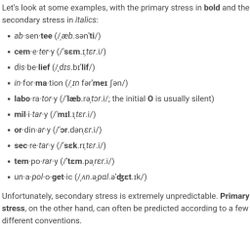
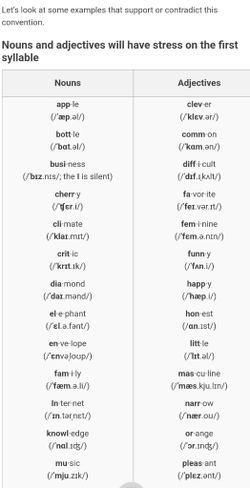
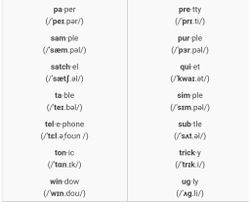
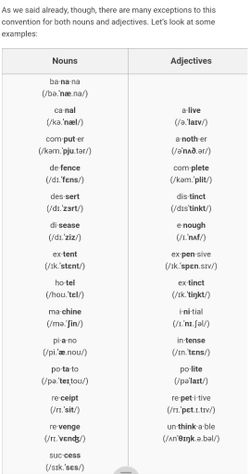
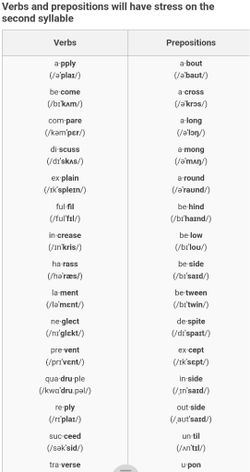
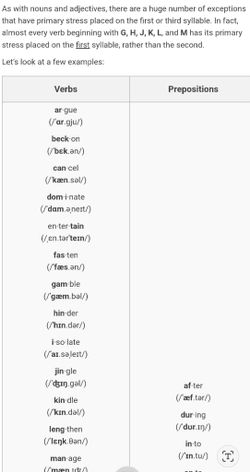
1. I gave the EL-e-phant an APPL-e.
2. The FAM-ily is a LITT-le CLEV-er.
3. Some PEOP-le are MAS-cu-line and some are FEM-i-nine.
4. She id HAPP-y, HON-est, and PLEAS-ant.
5. I wrote a PA-per a-BOUT the CLI-mate.
1. I ate a ba-NA-na for des-SERT.
2. I live in the DES-ert.
3. I have had e-NOUGH of this ho-TEL..
4. Is the po-TA-to ex-PENS-ive?
5. re-PET-i-tive re-VENGE in un-HEALTH-y.
1. Let's diSCUSS how to preVENT CLImate disASter.
2. unLESS we quaDRUple sales, we will not sucCEED.
3. Don't come aROUND here and haRASS us.
4. AFter the MEETing there was noTHING to ARgue about.
5. Can you MANage to enterTAIN us with a JINGle
By undefined
27 notes ・ 373 views
English
Upper Intermediate